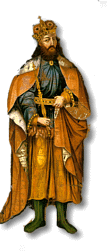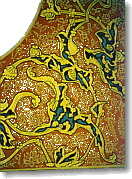The Residence Quarter
The Residence Quarter houses the Old Residence (32), the New Residence (36), Offices and the Treasury Museum (37). Visitors are allowed to view the Old Residence as long as they are escorted but the New Residence and Treasury Museum are open by invitation only.
The Residence Quarter is on the western side of T'rdat Gate. A guard station is on the southern side of the gate.
They don't keep official hours at the Old Residence, but we were told to come by in the mornings and early afternoons during the week, and after High Service (about 1pm) on Sundays.
Residence Quarter Grounds
The quarter itself holds some beautiful Khachkar examples:
35b. Geghard Khachkar, XIII c.
Red tuf with tree of life opening to twelve spirals. The ends of the cross are formed from a continuos geometric knot pattern, and the sun disk is made from two birds with their necks intertwined.
35c. Geghard Khachkar, XII-XIII cc.
35d. Geghard Khachkar, XIII c.
35f. Aghdjotsk Khachkar, 1278
Deep geometric patterns forming a patchwork of crosses in the frame surround the central cross with two smaller ones resting on a large tree of life.38. Winged Khachkar, XVII-XVIII cc.
39. Hovhanavank Khachkar (by Vardan), 1171
40. Khachkar
41. Gladzor Khachkar, 1279
42. Hairavank Khachkar, IX c.
44. Gladzor Khachkar, 1296
Old Residence
This 1736 building was both home and office for the Mother See until the New Residence was completed in 1962. In 1971 it was converted into a museum to house artifacts and treasures of the church.
The Old Residence is open to walk-in visitors, but you need permission and an escort to get past the guard. Ask around the compound to speak to Husik S'rpasan or Hai-Nerseh, who grant permission to enter the museum. Husik S'rpasan doesn't speak English, so ask him "Karogh em aitselel hin veharanuh?" /kah-GHO ehm ai-tseh-LEL heen veh-hah-RAHN-uh/ 'May I visit the Old Residence?'). You can also ask for Greta, who is the caretaker and guide for the Old Residence, but she has to get permission before letting you in.
The effort is well worth it, since the Old Residence is probably the most interesting museum in the complex, presented in much the way it was when in use as the office and residence for the Mother See during the 18th-19th centuries.
Outside
There is a small courtyard outside with five Old Djuga Khachkars and an animal icon from the 1st millennium BC. The Khachkars are examples from the old Armenian quarter in Djuga:
a. Khachkar, Old Djuga, 1603. The cross is carved like the frame of church window. Top panel shows seated Christ with geometric designs on both sides. Bottom panel has kneeling figure of donor in fornto of sun symbol.
b. Khachkar by Grigor, Old Djugha, 1603. Masterpiece of geometric design with cross in a ‘window case’. Top panel shows four supplicants on either side of enthroned Christ seated over the four evangelists.
c. Khachkar, Old Djuga, 1603. Deeply etched cross in gothic-style window representation, with double bodied winged horse and kneeling angels in top panel.
d. Khachkar, Old Djugha, 1603. Five crosses in top panel, memorial carving of prince on horse at bottom.
e. Khachkar, Old Djugha, 1603. Geometric sun symbol has design echoed in side panels and the stylized tree of life on either side of the cross. The Persian influence is clearly seen in the repeated shapes and the florid details.
There is also an exquisite wooden khachar panel inside the portico, lower level. It is unbelievably intricate in its design and execution, and sadly, deterioriating to the degree that musuem staff are afraid to move it indoors for fear of it crumpling. It is 18th-19th c (dating unsure). See it now before it evaporates.
Inside
You enter through an antechamber which holds a variety of silver and bronze Meron Vessels and three ceremonial pitchers used to pour fragrant essences from Kilikia, Armenia and Balasah. Also in the antechamber is a 13th -century Khachkar.
The main residence is up a flight of stairs flanked by five large paintings, Christ in Gethsemeni (Arshakvert), The Annunciation, "Voghp" (Pahlevi, 17th c), The Crucifixion, and a large 1835 Last Supper.
The Office
The Office is left as the Katoghikos Gevorg VI (r. ) used it. When you enter this space, you go back in time to the lives of 20 Katoghikos. The floors are covered with 16th-18th centuries carpets, the walls are hung with early 19th -century Mkrtum Hovnatanian paintings and others of Gevorg VI, Khoren Murahakian (reputedly killed by order of Stalin in 1938), Gevorg IV, Martiros Izmilian and Nerses Ashtaraketsi. The Hovnatanian paintings include Aram Takavor (King), Trdat Takavor, Tigran Takavor and Agat Takavor. Display cases show vestments, gold and silver implements, and a collection of staffs in ivory, silver, gold and gold with imbedded jewels.
Second Room
This small room has a display showing objects belonging to Khrmian Hairik, including a large amber tsbekh and silver watches. An 18th c mosaic is opposite as is a collection of mitres and silver crosses. The carpet you are walking on is a Kharabi and like the icon to your right, is 17th -century.
Khohanots (Kitchen)
The old kitchen has a large fireplace set into a niche on the far wall. In front is a display of china, samples of those used by each Katoghikos who lived here. On the walls are photographs and paintings including a small one, Nerses Ashtarak Meets the Russian Army, which was a favorite of Vazgen I (no doubt an inspiration during the Soviet period).
A very small display case shows photos and letters belonging to Komitas, barely a fraction of the collection from the old Komitas Museum which was closed to make way for the Gevorgian Seminary. 18th century manuscript miniatures also line the walls.
Dining Hall
The most striking part of the Dining Hall is the large 18th century wall hanging (a) with scenes from the bible. The painting was made by wood-print. It is as detailed as an embroidered tapestry. At the far end of the hall is the 1791 tapestry Son of Christ (b), incredibly detailed and intricate. The two 18th century paintings flanking the tapestry are David Anhakht (Invincible) (c) and Movses Khorenatsi (d), by Hovnatan Hovnatanian (1730?-1801). Icons (e), tapestries and woodblock paintings (f) line the other walls, as do glass cases (g) holding gold and silver embroidered vestments, gold, silver and jeweled scapulars, crosses, miters and belts. The 18th century hand-woven carpet is based on a dragon design.
The most amazing piece is usually missed by visitors. The black wrought iron chandelier (h) is so intricate and smoothly executed it is often considered machine made. Adoerned with clumps of grapes abd delicate vine tenrils, the piece is actually 11th c. made for an Armenian prince in Kilikia.
The centerpiece of the residence is the throne room, where the Katoghikos held council and met dignitaries. The ceiling (a) is lined with two tiers of oriental pilaster work, covered with frescoes painted by Hakop and Harutiun Hovnatanian between 1739-1740.
The frescoes are incredibly detailed using geometric patterns then in favor at the Persian court, yet on closer look they are actually from Armenia's medieval manuscript tradition. They have never been retouched. The oriental carpets (b) were made by Armenian weavers in the 18th century and follow the patterns established by Hovnatanian on the arches. The throne (c) was carved in 1838. The paintings in the throne room are portraits of Gevorg IV, Khrmian Hairik (d) (Y. Tadevosian, 1900), Markar Katoghikos (who brought Komitas to Echmiadzin), Hovsep Aghutian, and The Vision of Gregory the Illuminator (Y. Tadevosian, 1901) and an embroidered Echmiadzin Cathedral (e).
In the small room off the throne room are two pieces of note: a 16th century chandelier using a dragon design, and the 18th century walnut chair in the corner. Carved from one piece of wood by a Spanish Armenian, the chair is an intricate web of design, resting on carved lion heads.



